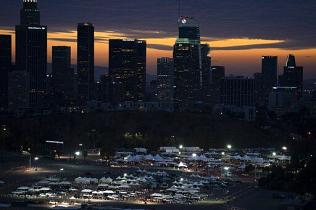San Francisco, Los Angeles lead California business reopening pace
LOS ANGELES (AP) — San Francisco has largely beaten the coronavirus pandemic by avoiding it, while Los Angeles was nearly beaten by it during a deadly winter surge.
But both emerged simultaneously Tuesday as the first urban areas in California to reach the least-restrictive tier for businesses to reopen.
California’s signature cities met infection and vaccine thresholds to allow indoor bars to welcome people again, larger crowds to cheer on Major League Baseball’s Dodgers and Giants, and expanded capacity at restaurants, movie theaters, amusement parks, gyms and other establishments.
It’s a remarkable turnaround for LA considering it was ground zero for infections and deaths when California was the nation’s epicenter of the virus outbreak just a few months ago.
“It was horrible,” John Pryor said Sunday after one of his few outings at the recently reopened Angeleno Wine Co. near downtown LA. “It’s crazy that we were in the worst place in the country and now all of a sudden we’re the best.”
California has the lowest infection rate in the country. Los Angeles County, which is home to a quarter of the state’s nearly 40 million people and has endured a disproportionate number of the state’s 60,000 deaths, didn’t record a single COVID-19 death Sunday or Monday, which was likely due to incomplete weekend reporting but still noteworthy.
A total of seven of the state’s 58 counties are now in the so-called yellow tier, which is the final stage of a phased reopening plan before a projected return to business as usual June 15. The five other counties are all remote areas of Northern California.
On a map showing the status of each county, LA and San Francisco are yellow islands in a sea of orange, the second-least restrictive tier. There are 39 counties in the orange tier, home to 60% of residents. A dozen counties, mostly in the agricultural Central Valley, are in the second-strictest tier and none remain in the strictest category.
San Diego and the state’s other most populated counties, which fared better than LA through much of the pandemic, remain at least two weeks from a broader reopening.
However, the Navy announced Tuesday that it was ending some strict COVID-19 rules for tens of thousands of San Diego-based sailors.
For the first time since last year, sailors will be allowed to visit public beaches, dine at reopened restaurants and patronize local bars, while restrictions for some on-base facilities will be relaxed, the San Diego Union-Tribune reported.
The move comes as signs of life are returning to California streets that emptied, shops and restaurants that closed and office buildings that went dark after a statewide shutdown in March 2020.
Freeways are becoming congested, workers are returning to offices, and people are getting together for drinks and dinner, much of it still al fresco style.
On Sunday in downtown LA’s vibrant Arts District, where colorful murals cover former industrial buildings, drivers circled the block looking for parking spaces. Diners filled the sidewalk tables of Wurstküche, eating sausages and drinking Belgian and German beer.
Standing in a line of people waiting for a table at Angel City Brewery that extended down the street, Chris Sammons said he felt a civic obligation to support businesses.
“It feels like almost a duty to be engaged with the city,” Sammons said. “We have to bring LA back to life.”
It was the first outing for his friend, Stephen Tyler, who had hunkered down for so long and had recently been vaccinated.
“It’s just good to be out in the city again, be around people,” Tyler said. “Even this, I don’t care about standing in line. It’s all kind of new again.”
In San Francisco, business has picked up at Mixt, a popular lunch spot for salad lovers in the Financial District. But it’s not at pre-pandemic levels when lines spilled outdoors, said Leslie Silverglide, co-founder and CEO of the the chain. She plans to open two more stores downtown in coming weeks.
“It seems as if people are coming back,” she said. “They’re excited to be having lunch with colleagues again.”
Fear of catching the virus prompted a huge drop in mass transit ridership. But Jason Alderman said he felt like a kid on his first day of school when he took a commuter train into San Francisco when his company reopened its headquarters in late March.
“Instead of feeling like a hollowed-out ghost town that people had quickly abandoned, it felt like there were green shoots of life,” he said. “I felt a twinge of the energy that used to be there.”
When the lockdown order came, an estimated 137,500 workers for San Francisco companies that include Google, Facebook and Uber, seemingly vanished overnight.





